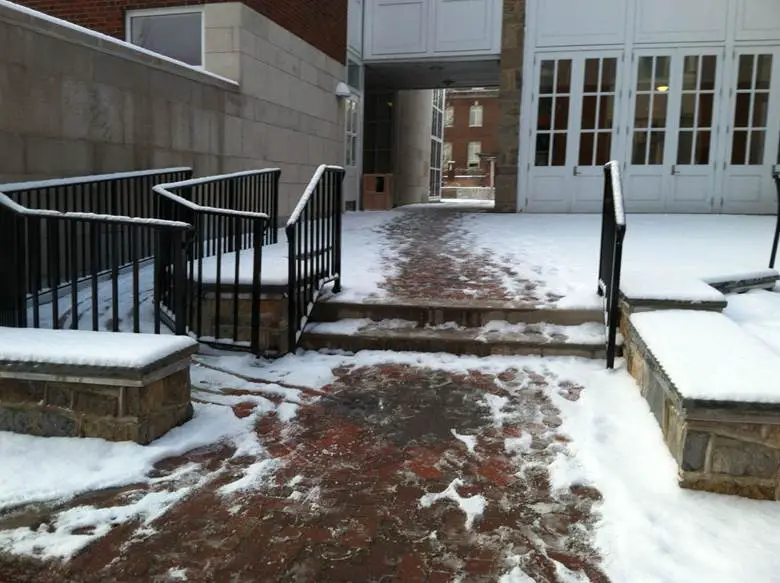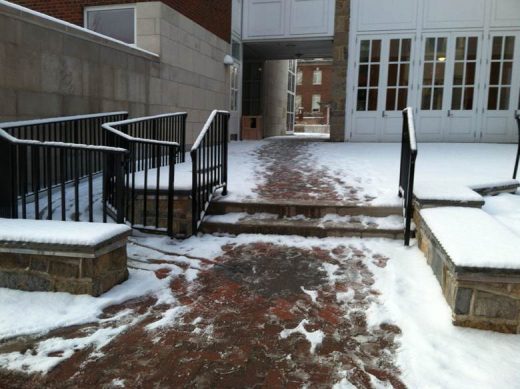Disability Access Design, Stairs and Ramps, Architects, Aging Population
Disability Access : Architecture Design
Managing Movement in and around Buildings – article by Joel Solkoff, 27 Feb 2013
Feb 27, 2013
The future of architecture as the “baby boom” generation retires
Disability Access Article by Joel Solkoff
As one born two years after World War II, I have been fortunate to be a paraplegic for the past 18 years—getting a head start on my fellow baby boomers. For architects, I have slowly but persistently developed design perspectives that should be useful to you. The future of architecture is rapidly requiring you to redesign the world to meet the requirements of the largest generation in world history. Ours is an aging population in the process of developing disabilities–but a generation with the determination, education, political clout, and for many the wealth to live independently none-the-less.
++++
Stairs and ramp replace a zero-step tolerance gentle slope “All politics is local,” the late speaker of the U.S. House of Representatives Rep. Tip O’Neil observed. The photograph above illustrates the narrow-minded thinking of professionals paid to provide access for individuals with disabilities, but do not know what they are doing because they are not disabled and did not consult with people who are. What the world’s architects are about to experience is politics in the broadest sense of the term as the world baby boomers retire and become disabled. This local example may help architects get a better understanding of the work ahead given, for example, that:
• Only eight percent of the homes in the U.K. are wheel chair accessible
• Over 90 percent of the homes in the U.S. are inaccessible
• For most new home construction, stairs are still a consistent feature
For over six years, I have taken my scooter from the garden area directly ahead (facing the photograph) toward the Department of Architectural Engineering (AE) where I am a research assistant.
In January, Penn State’s Office of Physical Plant, which functions as an otherwise efficient contractor for University clients, replaced a stretch of pavement which sloped slightly as I came to work.
Often daily, I rode my mobility device without pause or the now necessary need to navigate cautiously down to the AE Department’s Immersive Construction (ICon) lab where I advised virtual reality modeler Sonali Kumar on disability aspects of an independent living residence model.
Before that, I used the same route to the Engineering Building where, as a graduate student, I did independent research on the effectiveness of campus accommodations for disabilities. Professor Richard Devon, an expert on universal design, ensured me access to administrators who made the decisions on the university’s accessibility in conformity with the Rehabilitation Act of 1973 and the Americans with Disability Act.
The Rehabilitation Act is especially powerful because unless the institution receiving federal funds conforms, funds are withheld. Sadly, conforming to regulations is often more important to administrators than meeting the requirements of the disabled. The photograph is an excellent example of this kind of obliviousness where the presence of a ramp appears to conform to regulations when previously no ramp was required. The “improvement” is unnecessarily expensive and dangerous. There is no sign warning of what is to come. Late one afternoon in February (when this photograph was taken), the area was getting dark; I nearly drove down the stairs for want of visibility. [The fact that the stairs were shoveled and the ramp was not….]
++++
As I look at the work of architects on e-architect, I see stairs—unnecessary stairs, stairs which exist solely for the purpose of ornamentation like columns on modern houses in the U.S. state of Georgia which provide no structural value but imitate the mansion of Gone with the Wind. Live fast, die old, a BBC News article, noted that companies have failed to understand the wealth U.K. baby boomers have at their disposal viz., “80% of the UK’s wealth and buy 80% of all top of the range cars…” They are currently in the market for architects who will build accessible housing—housing which will allow them to age in place, a phrase that has become a term of art in academic literature.
Conversely, a Google search will quickly show concern for those boomers without money in their pockets who will be straining social services. Right now, the U.S. budget for Medicare and Medicaid, health insurance for the elderly and disabled, is larger than the Pentagon budget and growing rapidly as inadequate housing forces the elderly into astonishingly expensive nursing homes because of falls and the stress of living in an environment designed by architects who have failed to live up to Vitruvius’ standard of utility.
Seventy six million U.S. citizens born after World War II, the so-called baby boomers, are beginning to retire at the rate of 10,000 a day. The UK census returns show a 30 percent increase in the overall number of people turning 65 in 2011 over the previous year. Retiring baby boomers in Canada, Japan, Australia, Italy, and indeed through most of the developed countries represent a world-wide phenomenon of a generation noted for the quality of our education, our history of rebelliousness, and the force with which our numbers change the landscape of the world. Consider that the bulk of the U.S. population shifted from cities to suburbs in my lifetime.
Ours is an aging generation which is in the process of experiencing a statistically high number of mobility, visual, and hearing disabilities. I know what is required to live independently to accommodate for one’s disability. Are the world’s architects even thinking about what they must do to avoid the inevitable bankruptcy that must follow your obliviousness?
“Why, then, must our buildings ignore who we are?” writes Trevor Tucker in e-architect.
–Joel Solkoff
Joel Solkoff – regular guest editor at e-architect
International Architectural Designs
New Houses

photo : Daniel Hopkinson
Disability Access Architecture
Website: Architectural Walking Tours
Comments / photos for the Disability Access Design Article page welcome



